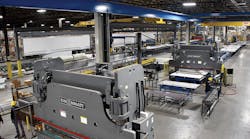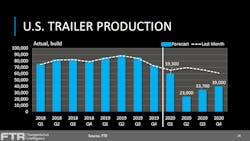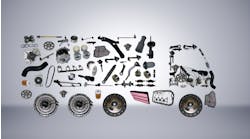It’s still too early in the COVID-19 pandemic to know what to expect, but the industry analysts at FTR have nonetheless made an early attempt to revise their 2020 freight transportation and commercial vehicle forecasts. The bottom-line business outlook is sobering: a sudden and shocking return to Great Recession levels of truck and trailer production.
But, as FTR Chairman and CEO Eric Starks was quick to point out in a recent online presentation and follow-up call, the coming economic downturn will have little in common with past recessions.
“We have to remember that the Great Recession was a traditional recession in the sense that we had an imbalance in the economic system and the financial system,” Starks said. “In this case, that is not what's driving it. This is an artificial slowdown, people having to stop production and output is coming to a halt—which is fundamentally different.”
Starks also noted the forecast had been modeled just as the US government reported that a record 3.3 million Americans had applied for unemployment the week before (and that number doubled for the week after)—which means additional consumer pressures to be factored into the FTR forecasts.
The good news is that the recently passed $2 trillion relief package is designed to support employers forced to make temporary job cuts.
“If this is successful—there's a lot of ifs here—we could see a faster rebound because you have kept your workforce in place,” Starks said. “So, when demand comes back, and we can get back to a more normalized environment, you could see a faster ramp up than what we are currently saying. It’s still a lot of unknowns.”
During this uncertain period, FTR has made the firm's proprietary analysis and special reporting available to the public at FTRintel.com/Coronavirus, Starks added.
U.S. economy
Broadly, FTR forecasts an 11% drop in real GDP in the second quarter. Starks focused on the goods transport sector as the segment of GDP most critical to trucking and, in turn, the transportation equipment markets. FTR expects the indicator to be down 24% from the first quarter.
“And that’s huge. There is no getting around this: There are significant impacts in the system as we move into the second quarter,” Starks said. “We don't anticipate seeing any noticeable rebound until Q4, where we get into double-digit growth. A lot of that, though, is a return of inventory accumulation.”
Similarly, FTR projects a nearly 15% quarter-over-quarter annualized rate decline in industrial production for Q2, driven initially by production challenges rather than falling demand. Again, FTR doesn’t anticipate a rebound until the fourth quarter.
“To put some of these numbers in perspective, we don't get back to peak levels or to levels that we saw in 2019 until the middle of 2021,” Starks said.
The wildcard in the forecast is the timing of the recovery, he emphasized.
“What we don't know, as of now, is how long does the virus stick around?” Starks said. “What we are seeing right now indicates this is not a quick turn. It suggests that some of this lingers on into the summer and into the fall.”
As for freight specifics, the Q2 collapse translates to an anticipated decline of almost 11% in US freight ton-miles, and that’s after a 5% slip in Q1 and with an additional drop off 4% in Q3. This replaces FTR’s previous forecast that called for a 3% rebound in freight in Q2.
Trucking outlook
Given the shutdown of the US economy, “trucking is going through something, I think we all understand, it's never experienced before,” explained Avery Vise, FTR vice president, trucking. “You have just this whole cascade of issues that [truckers] are having to deal with.”
Vise likened the situation to a hurricane—except the coronavirus outbreak is a national disaster rather than regional one.
Aside from driver health concerns, Vise noted the “enormous” near-term stress that panic buying has put on networks due to the restocking demands for stores and distribution centers. Refrigerated freight, specifically, has seen a spike in load availability, while both dry van and refrigerated spot rates have been sharply higher.
“However, it would appear that non-essential freight transportation is taking a hit, as we certainly would have expected,” Vise said. “Flatbed spot loads were down fairly sharply, and this is quite a hit for flatbed—especially with housing starts. Activity in spot market had been growing quite strongly and approaching load levels that we hadn't seen since 2018.”
However, Vise suggested that restocking demand for certain consumer goods “could dissipate fairly quickly.”
FTR’s forecast now calls for truck loadings to be down 4% in 2020, that’s a downward adjustment from the pre-COVID-19 forecast that expected a 1.3% increase in loadings. By segment, Vise anticipates flatbed will slip 6%, with dump/bulk freight down more than 9%. Dry van and tank loadings will down slightly, while refrigerated loads will post the only increase on 2019 “because people still eat”—although the distribution of foodstuffs “has changed dramatically” as restaurants have been closed and events have been cancelled.
Vise did note than an infrastructure package—an idea the White House and congress have begun to discuss seriously in the days since the FTR presentation—would have “some positive effects” on freight and trucking.
As for truck drivers, Vise suggested that while lagging demand will ease the driver recruiting and retention pressure on carriers in the near term, the anticipated boost in federal unemployment benefits could it make it difficult to get drivers back to work when the freight market improves. The post-pandemic driver pool will also be impacted by the federal drug test clearinghouse that is now in place, and the legalization of marijuana in a number of states.
“The overarching point in all that is that, when we come out of this period and we do need drivers, we may find it a little more difficult to get them than we’re anticipating.”
Declining import container loads, low truck rates and cheap diesel fuel will only increase the pressure on the intermodal market, added Todd Tranausky, FTR vice president, rail and intermodal.
“The rail intermodal space is not going to be immune to the effects of the coronavirus,” Tranausky said. “Intermodal really has been on the bleeding edge of it so far—it really has taken it on the chin. This is because a lot of intermodal goods are imports from China and because of the measures China took, closing factories.”
Container loadings, which were running down 6% from late 2019 into January, crashed in mid-March, down nearly 12%.
Equipment production
The most dramatic declines in the forecasts came from the charts of Don Ake, FTR vice president, commercial vehicles.
For North American Class 8 production, the outlook has dropped from 260,000 units in 2020 to 155,000 units. That compares to the more than 350,000 Class 8 trucks built in 2019.
“The key thing to notice on the 24,000 units in Q2, that is roughly equivalent to the worst three months in the Class 8 production during the Great Recession—so we're looking for a significant downturn there,” Ake said.
And the forecast doesn’t improve a lot, at least compared to FTR’s pre-virus production outlook that showed about 60,000 Class 8 units per quarter, Ake now has Q3 at 30,000 units, climbing to 38,000 in Q4.
Trailer production will also see a steep decline in 2020. According to the FTR forecast, production will come to 155,000 units, compared to the previous forecast of 275,000 units. Last year’s record production topped 325,000 units.
“Once again, the second quarter will be very disruptive, both in terms of demand and just trying to keep the plants running and finding people to work in the plants,” Ake said. “It's very consistent with what we've seen in Class 8.”
On top of the uncertainties around COVID-19, Ake added that customers already had taken a “wait-and-see” approach to trailer orders for 2020. Simply, truck and trailers orders will be the number the to watch for an early—if obvious—sign the worst is over.
“The OEMs were slightly frustrated in that there were a lot of quotes out there for bid—and that was a great sign, in that the OEMs expected the year to be decent—but fleets were just waiting a little longer before committing. Now all that uncertainty has just been multiplied: The wait-and-see factor is still there, only it's going to be extended.”
Ake was quick to note, however, that the FTR forecast is “conservative,” and that the market certainly could recover more quickly.
“I did talk to a supplier just this morning, and what he was telling me is that he has not seen that the type of disruption yet that we're showing in the second quarter,” Ake said. “The key thing is we've got to keep watching this closely.”
FTR special reporting
With markets in disarray and much uncertainty on what will come next, FTR has focused the work of its team of freight experts and the Freight•cast forecasting model on providing unbiased outlooks and insights to more than just its clients.
The freight transportation research firm has published a series of reports that are now available to the public at FTRintel.com/Coronavirus. As prevention steps and shutdowns due to the novel coronavirus continue to impact global markets, FTR will be updating this page and allowing open access to the intelligence it can provide to help businesses navigate this situation. “The economy and freight transportation have been turned upside down, and it is more important than ever to offer everyone an unbiased look at how we see the environment changing. The more information you have, the better decisions you can make,” Starks said. “We have been producing content to keep our clients in the know, yet I feel it is our responsibility to help everyone through this difficult time. This is why I have instructed the FTR team to provide as much content and analysis to the public as possible about the impact of this crisis.”
Key headlines from the reports available for download:
- All sectors of transportation will feel dramatic effects from the coronavirus shutdowns.
- Economic forecast moves sharply lower as many downside risks are already in effect.
- Rail equipment is in for an extended downturn.
- A sharp economic contraction will slam CV production.
- FTR expects a recession, with major downside risks.
Additionally, FTR has released a new interactive dashboard. The FTR COVID-19 Impact Heatmap assesses the state-level rate impacts by four trucking equipment types—dry van, refrigerated, flatbed, and specialized—using Truckstop.com spot market data. Each combination of states and equipment type reflects rate trends for the states both as origins and destinations using the most recent seven days from the date selected.
FTR also plans to develop additional dashboards to provide greater visibility into how COVID-19 is affecting transportation. The next feature to be added to this map will show truck load volumes.





